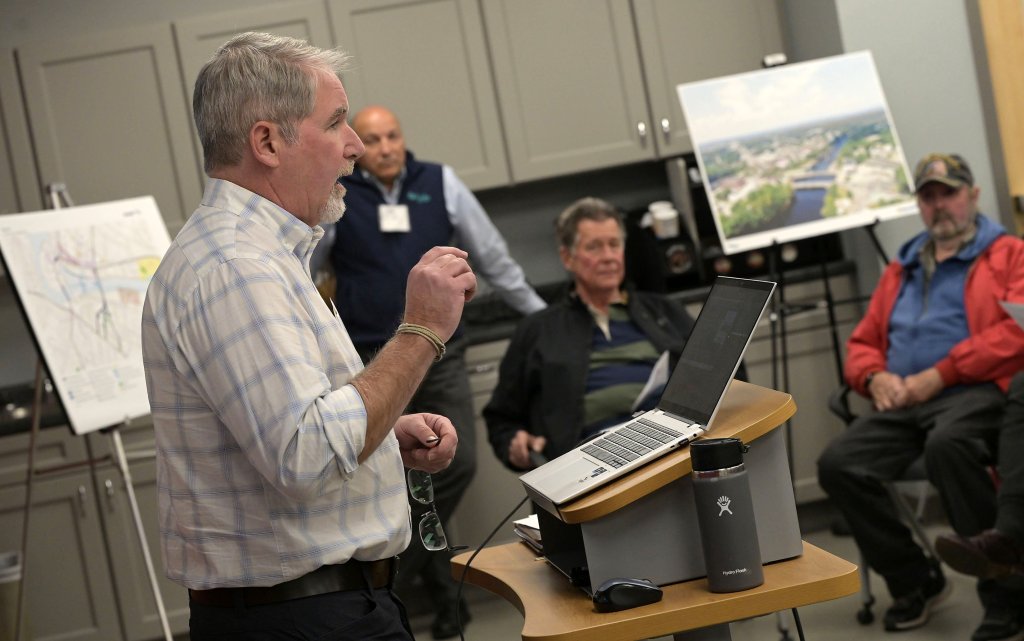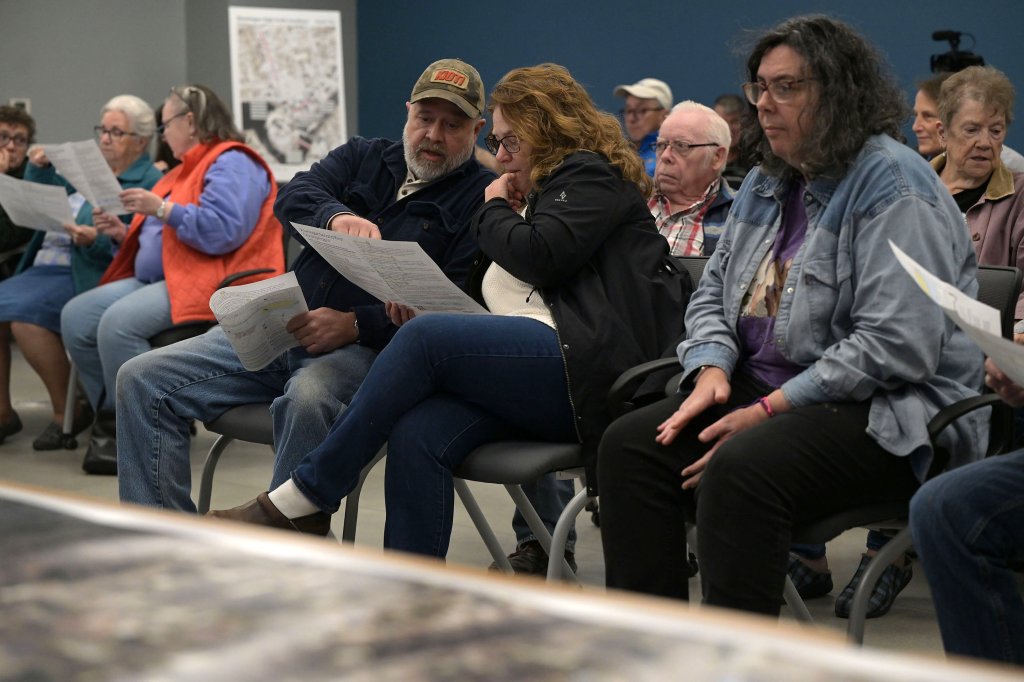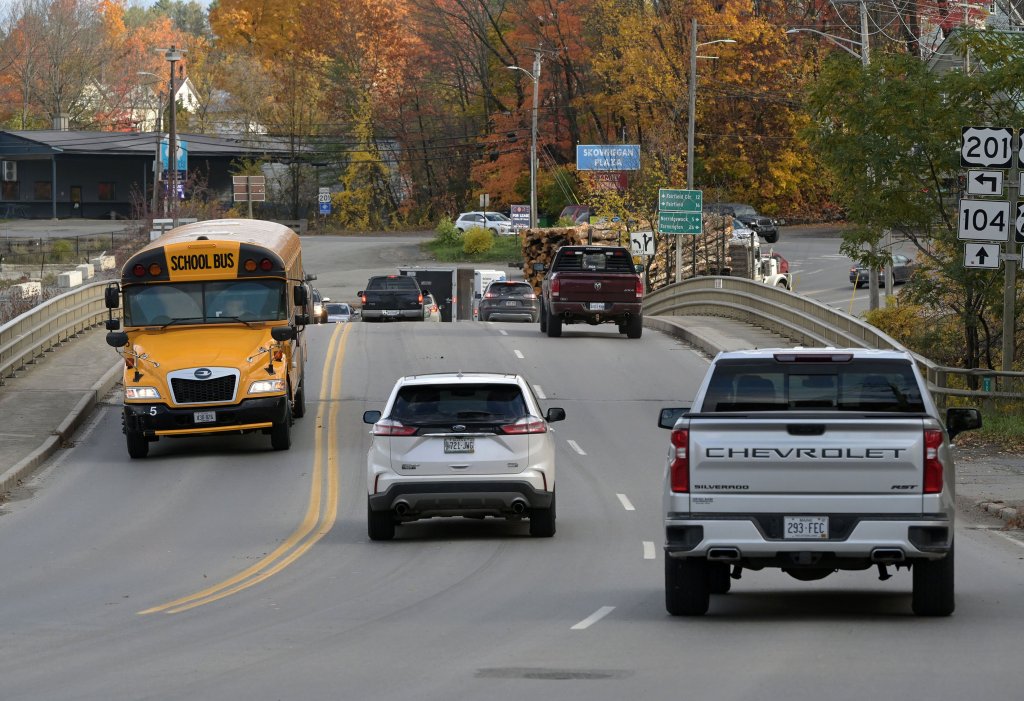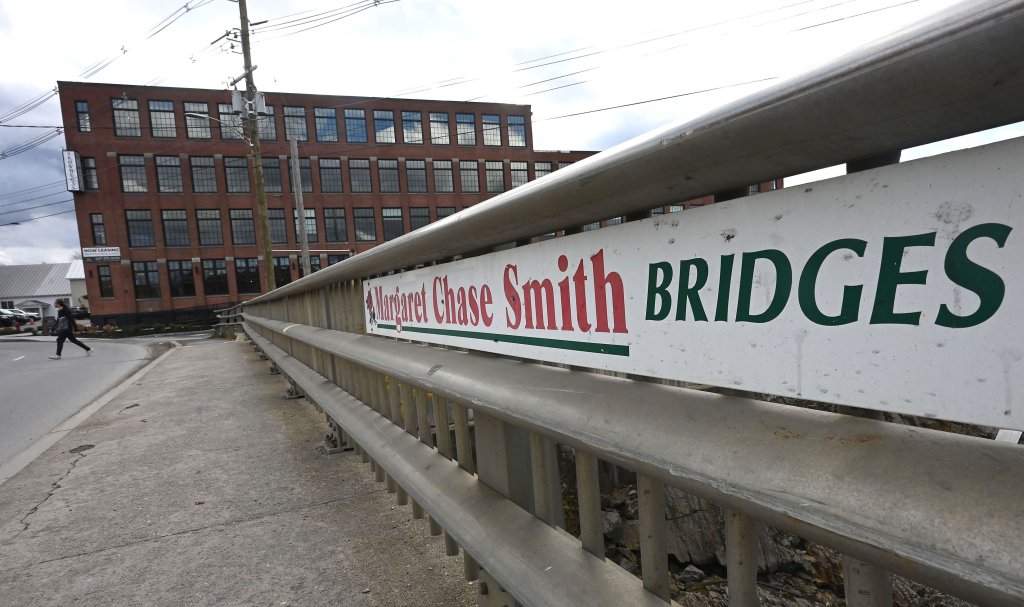
SKOWHEGAN — The long-studied proposal to build a second crossing over the Kennebec River could still be almost a decade away from becoming reality, state transportation officials told residents Wednesday evening.
The meeting, which drew about 70 people to a packed room at the Skowhegan Public Safety Building, marked the kick off of the first phase of the latest effort to explore building a second bridge over the Kennebec River.
State engineers and their hired consultants emphasized they have settled on the general location downtown — in line with Route 150 on the north side of the river to link U.S. routes 2 and 201 and state routes 104 and 150 — but still have many details to study and challenges to overcome.
Among those include evaluating potential impacts to historic properties, a veterans memorial, homes, endangered species and the planned in-river whitewater River Park; designing a bridge that would likely require a relatively steep grade; and analyzing other traffic improvements and alternatives.
“This project, I know, has been batted around this community for, not just years, but literally decades at this point,” said Pete Walker, a project manager with the engineering consulting firm Vanasse Hangen Brustlin, or VHB. “There has been some really significant progress over the last several years in the form of two recent transportation studies.”
The studies led local and state officials to prioritize a second river crossing, specifically near downtown Skowhegan, in addition to the Margaret Chase Smith Bridges that carry traffic on and off the island.
With that preliminary idea, the state is now undertaking an environmental review process under the National Environmental Policy Act. The federal guidelines apply because the state anticipates Federal Highway Administration dollars will supplement state funding for the project, which at this point has no ballpark cost estimate.

“For this phase of this process, we’re really at the beginning,” Walker said. “Our real focus is on the preliminary engineering and evaluation of design alternatives.”
The Maine Department of Transportation is seeking feedback from residents at this stage of the process. People can view a virtual version of the public meeting and leave comments online.
People with questions, comments and other inquiries about the project can also contact Maine DOT Regional Planner Matthew Drost via email at [email protected] or via telephone at 207-441-1879.
The public has been asked for input many times in recent bridge-related efforts. Over the course of two state-led studies of Skowhegan transportation infrastructure in the last six years, officials reported holding nine study team meetings, nine advisory committee meetings, six Village Partnership Initiative meetings, six public meetings and two open houses. They also circulated four different surveys.
And even more opportunities for public input are expected as the current iteration of the project progresses over several years.

Drost, presenting a rough timeline subject to change, estimated the environmental review now underway would take 18 to 24 months, final design and permitting would take two to three years and project construction would take two to three years.
Permitting and funding issues could lengthen the timeline, although it is possible some phases could move more quickly, Drost said.
In the environmental study phase, engineers are looking at a variety of impacts, said Tony Grande, a transportation engineer with VHB.
The goal is to evaluate impacts as they relate to the project’s purpose of the new downtown bridge, which Maine DOT has defined as a key link among major roads that would:
• Provide an additional route over the Kennebec River for emergency vehicles and trucks.
• Minimize or eliminate long-distance detours when the Margaret Chase Smith Bridges are closed to due flooding, crashes and special events.
• Reduce existing traffic congestion at the Margaret Chase Smith Bridges during peak travel times.
• Address high-crash locations in Skowhegan.
Grande said engineers are looking at possible alignments of the bridge and necessary changes to intersections to accommodate traffic coming on and off the bridge. They are also analyzing other potential impacts, such as the potential need to move the Veterans Memorial Park, an issue raised in previous studies.
“No matter where we go … there will be impacts from this project,” Grande said. “There’s no doubt about it. That’s one of the things we’ll have to try to balance as we move forward.”

Steve Hodgdon, a bridge engineer with VHB, said the proposed downtown location presents hurdles for design and construction. The south bank of the gorge is much higher than the north side, Hodgdon said, and bridges do not generally have a steep grade for safety reasons. The span over the river would be about 300 feet.
“It’s a really challenging site,” Hodgdon said. “How do you build it? It’s very challenging. We’ve also brought on a construction expert that’s going to work with us.”
Maine DOT settled on the downtown location, however, after a 2021 bridge feasibility study and a 2024 master plan transportation study identified it as the best location.
The 2021 study looked at several alternative locations, both upstream and downstream of the existing Margaret Chase Smith Bridges. Those proposals were later narrowed to two.
The other of the final two options, farther downstream near the Great Eddy, was ruled out during the master plan study in 2024 as part of the Village Partnership Initiative, or VPI.
The prospect of a second bridge took on new urgency during the VPI process after historic flooding following a major storm in December 2023.

The rising river forced the closure of the Margaret Chase Smith Bridges to nonemergency traffic for nearly two days, cutting off one side of the town from the other and affecting first responders’ ability to handle emergencies. Those bridges are the only way for a vehicle to cross the river in town.
Around that time, Maine DOT officials also shared that the Margaret Chase Smith Bridges are due for maintenance in the next decade, which would require the construction of a temporary bridge to detour traffic.
The group of local and state officials and other stakeholders studying various traffic and transportation improvements as part of the VPI decided then that the construction of a second bridge should be a priority among other projects on the table. The effects of a second bridge would guide subsequent decisions, the committee largely agreed.

Town officials requested the state proceed with the project in 2024. The VPI master study, finalized this spring, memorialized it as a priority.
That marked a departure from the group’s initial outlook when it was brought together in 2022. Officials said at that time they were first focusing on other traffic improvements downtown while waiting to see how other infrastructure projects, including a new elementary school and the whitewater River Park, moved along.
The town first formed a committee in 1997 to study the issue of a second river crossing. In 2004, residents supported a new bridge in a nonbinding vote. Talks went relatively quiet for the next decade before officials began formally discussing the idea again in 2018.
